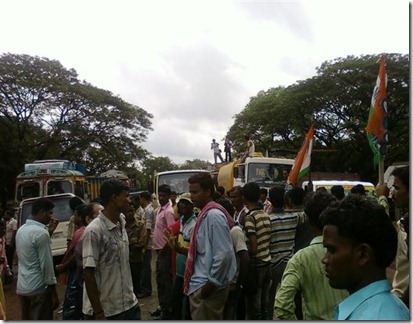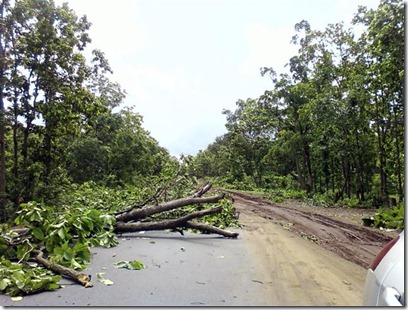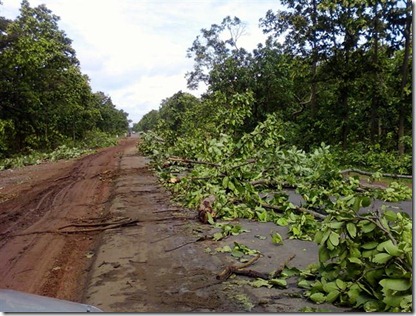To the North of Jamshedpur lie the Dalma range – a wide swathe of hills and dense forest. A 195 sq. km part of this range which is home to many wild animals has been developed by the Forest Dept. as the Dalma Wildlife Sanctuary. Dalma Hilltop, which is the highest point (about 3000 ft) in the Dalma range, falls inside this sanctuary.
One can either trek up to Dalma Hilltop or drive on a kutcha (unpaved but motorable) road which branches off from NH 33 about 15 km from Jamshedpur. This unpaved road leads right up to the Shiva Temple on Dalma Hilltop – a distance of 20 km from the entrance gate of the Dalma Widlife Sanctuary off NH33. Prior to 03.07.10, I had driven only once to the hilltop – in April 2002, in my Maruti Esteem. However, I have trekked up 3-4 times in recent years.
On 03.07.10 we (my friend Ronald D’Costa, his wife Marian, my elder daughter Debashree, and I) started from Jamshedpur at 5:40 AM in my Suzuki Swift VDi – our destination : Dalma Hilltop. It had rained off and on throughout the night and it was nice and cool early in the morning. As we started, a light drizzle set in. We reached the sanctuary gate around 6:20 AM and bought our tickets (a nominal Rs 20 per head). The person at the ticket counter cautioned us that the road was quite slushy due to rains and some stretches were bad.
We started driving up the Dalma and reached the Forest Rest House (15 km from the gate) around 7 AM. The caretaker permitted us to use the balcony (which has a panoramic view of Jamshedpur) and we had a leisurely breakfast which my wife had packed for us. Luckily, the drizzle stopped just then and we saw a beautiful bright rainbow spanning the entire township of Jamshedpur.
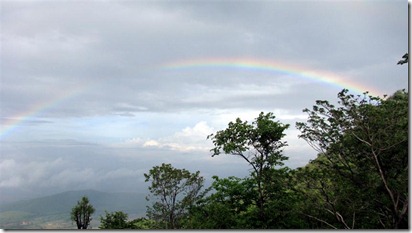
▲ Rainbow seen from Dalma
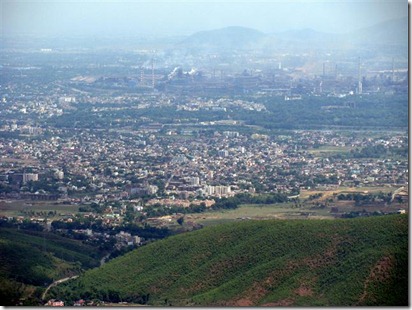
▲ Jamshedpur city viewed from Dalma
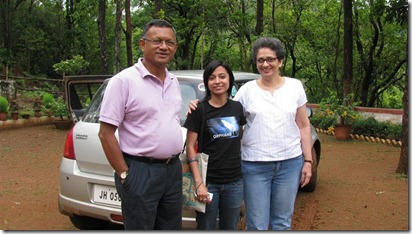
▲ Ronny, Debashree and Marian
After breakfast we resumed our ascent to Dalma hilltop, about 5 km away. The Swift was taking the climb on the slushy unpaved road quite effortlessly in its stride, we were chatting away merrily and all seemed to be right with the world. Suddenly, about 3 km from the Forest Rest House, we spotted an adult male wild elephant walking towards us in the middle of the road. My immediate reaction was to stop the car and pull over to the side of the road. I expected the elephant to go past us down the road and I thought it prudent to give him as much of the road as possible and make no noise or movement which could alarm or agitate the animal. Ronny too agreed with this course of action and I switched off the ignition.
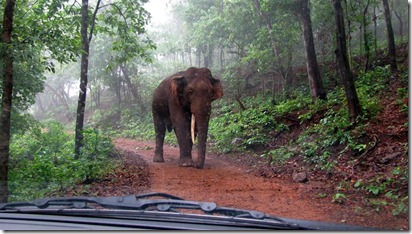
▲ Don approaching
But the elephant stopped about 40 ft away and kept staring at us silently for several minutes. We had no clue as to its intentions. Nor did we have any contingency plans for ourselves. Making the best of an unpredictable situation, I clicked several photographs of the elephant through my windshield. The elephant had only one tusk – the right one.
Suddenly, the elephant seemed to have thought things over and started moving towards us slowly but haltingly. We thought that it would go past us, but it came straight towards the car. It was frightening to see the huge animal headed directly towards us. After reaching the car, it actually nudged it with its trunk. We were petrified and thought that the animal could violently crush or overturn the car and kill us. Starting the car at this stage could have frightened or agitated the animal and I refrained from doing so.
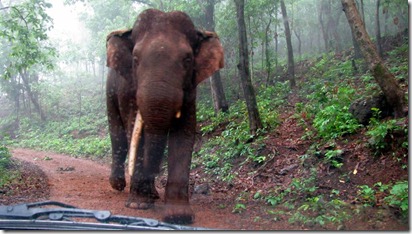
▲ Don just inches from car
As we were expecting the worst, the animal abruptly backed off. It walked backwards about 20 ft and stopped. Ronny advised that we should start reversing and I started the engine and started moving back slowly. But the elephant again started moving towards us. Driving backwards on that bad and curvy road, that too when my heart was in my mouth, was very difficult. Also, I did not want to block the elephant’s way by bringing the car to the middle of the road.
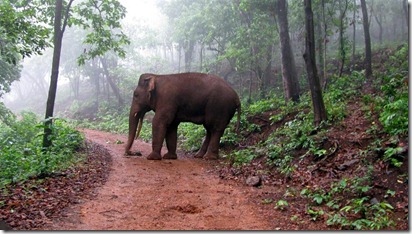
▲ Don contemplating its next move
Debashree then suggested that we should bail out of the car and take cover in the forest. I stopped the car, taking care to position it as much to the right side as possible. To the right of the road was the hill and the valley was on the left. Mercifully, as I stopped the car, the elephant also stopped. We all came out of the car and started climbing the hill rapidly. The elephant, which was standing about 30 ft away from the car at this time, kept staring at us but made no move to chase us or come towards us.
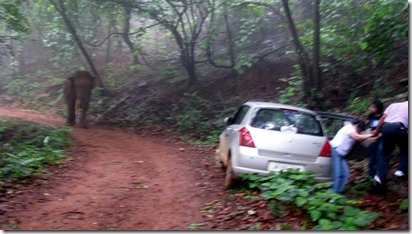
▲ Passengers escaping to safety
With our hearts palpitating like crazy, we climbed quickly and felt safer behind some large trees and boulders. Debashree decided to get help from the CRPF station (set up to combat Maoist insurgents) about a km up the road and continued trekking up. Ronny, Marian and I hid behind boulders and kept observing the elephant.
The elephant remained stationary for about 10 minutes. Then it approached the car and examined it closely. God alone knows what went on in its mind, but it decided to push the car further to the side of the road. First it pushed the front part of the car to the hill side and the front right wheel went into a shallow ditch. Then it walked to the rear of the car and kept observing the car for several minutes from the rear. Then it approached the car, lifted the rear end by a foot or so with its trunk, pushed it a little to the hill side and lowered it gently. Now both right wheels were in the ditch.
When I saw the elephant lift the rear end of the car, I was almost convinced that he had decided to wreck the car and it would be a matter of seconds before my car turned into scrap metal. I love my car and the prospect of seeing a rogue elephant wrecking my car was horrifying. But surprisingly, both his pushing actions were done very gently and damage to the car was minimal and superficial. It seemed that his intention was to merely push the car to the side of the road. Probably he looked upon the car as an unnecessary impediment on his way (though I had stopped it on one side, leaving most of the road free for him to pass) which needed to be pushed more to the side to prove who is king of the road.
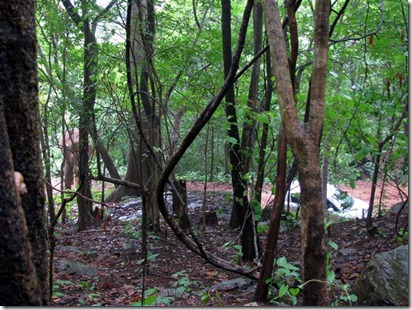
▲ Don stays behind car for a long time
After pushing the car, the elephant went about 20 ft behind it and observed the car intently for 10 minutes or so. He seemed satisfied with whatever he had done and decided that no further action was necessary. Thereafter he stopped looking at the car and started breaking some branches from nearby trees and eating. But he did not move away – as if a predator was guarding its ‘kill’. Only after half an hour or so it started moving downhill away from the car – that too haltingly. More than an hour elapsed before the elephant finally vanished from our sight and I felt bold enough to approach the car to inspect the damage.
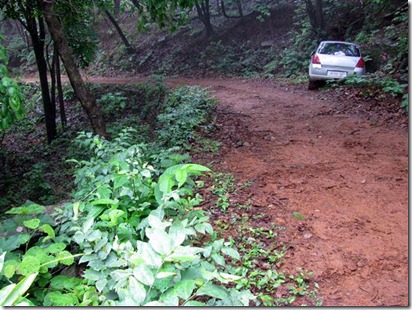
▲ Car pushed to hill side by Don. What if I’d left the car on the valley side?
The car appeared pretty much unharmed. The elephant’s tusk had gone right through the car’s rear bumper (plastic) and there was a gaping hole there. The left front fender was slightly damaged, again due to the tusk. That was about all.

▲ Rear bumper pierced by tusk

▲ Tusk mark on front fender and bumper
Of course, both right wheels were in the ditch and due to low ground clearance (170 mm) the rear part of the car bottom was virtually resting on the shoulder of the ditch. Luckily, this part of the shoulder was only earth and mud. If it had been stone, the car would have had to be picked up by a crane because any effort to move the car forward or backward (whether under own power or tow) could have damaged the car’s bottom.
I tried several times to come out of the ditch by using the engine – the car did move forward / backward a foot or so, but then the front wheels would start slipping in the mud. I tried to improve the traction by placing some leaves, twigs, etc. under the front wheels but could not succeed. We needed another vehicle to pull my car out. Ronny and Marian had joined me by this time and he phoned his son to arrange for a SUV to be sent to us.
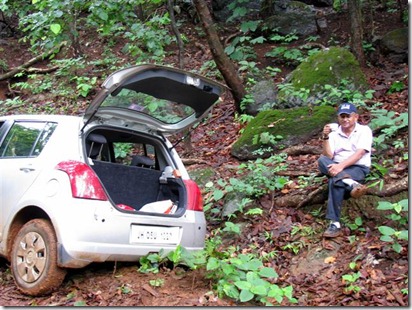
▲ Cool as a cucumber throughout, Ronny sips hot coffee poured from a thermos we carried
Meanwhile, Debashree had informed the CRPF station and they in turn had sent a message to the Forest Dept. But we were unaware of this and were getting worried about Debashree as she was not carrying her cellphone. Ronny took the trouble of trekking up to the CRPF station and escorted Debashree back to the car where Marian and I waited for help to arrive.
After a couple of hours Forest Range Officer and his staff arrived in a Tata Sumo. I had already fixed the towing eyebolt to the front of my car and was ready with a sturdy nylon rope which I always keep in my car. The Sumo pulled the car on to the road in a few seconds.
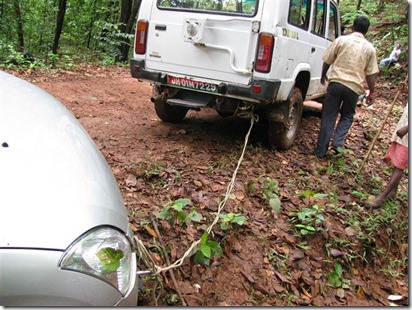
▲ Rope attached to towing eyebolt
In spite of the major ordeal we had gone through, we decided to complete our mission of driving to the Dalma Hilltop. We drove the Swift to the hilltop and then started descending after spending some time there. We were advised by the Forest Range Officer to halt at the Rest House on the way down to meet with Mr. S.E.H. Kazmi, Conservator of Forests (Wildlife Circle), Jharkhand who had driven down 120 km from Ranchi and reached the Rest House just then. Apparently, the message that had gone out from the CRPF post was that “a rogue elephant has demolished a car near Dalma hilltop and 3 persons are missing”. Obviously, this had created a lot of consternation in official circles and Mr. Kazmi decided to personally supervise the ‘search and rescue operations’.
Ronny and I met with Mr. Kazmi and other Forest Dept officials at the Rest House. The entire episode was analysed in detail. Following pertinent matters emerged :
- Emergency messages sometimes tend to get distorted while being transmitted from person to person. Avoidable panic was created in official circles (Police and Forest) due to a distorted message of distress.
- The seasonal migration route of wild Asiatic elephants passes through Dalma Wildlife Sanctuary and one may encounter wild elephants any time.
- Wild elephants usually do not attack humans or vehicles unless they feel unduly threatened or a particular elephant has become cranky or roguish due to some reason.
- This particular one-tusked elephant (nicknamed Don) apparently lost its left tusk during a fierce fight with another bull elephant some months ago.
- A month ago, Don brutally trampled a forest guard to death inside Dalma sanctuary.
- Don has been seen living alone (away from the herd).
- When the Forest Range Officer and his staff were driving up in their Tata Sumo to render assistance to us, Don (who had moved a few km downhill by then) blocked their way too for about 45 minutes.
- The main mistake we committed was switching off our engine. Apparently, when an elephant comes close to a vehicle and hears the purr of the engine, senses the heat and smells the fumes it perceives the vehicle as something alive and dangerous and usually decides not to mess with it. The same elephant (Don) came across two vehicles on the same day but its response was different only because in one car the engine was switched off and in the other it was running.
- If one is running away from an elephant, it is better to go downhill rather than uphill because elephants apparently move more slowly and cautiously while going downhill as they may lose their balance.
- All visitors to Dalma Wildlife Sanctuary need to be informed of the do’s and dont’s in the event of encountering wild elephants. This could be done through prominent signboards at the entrance gate as well as giving a printed leaflet along with the ticket at the counter.
We expressed our sincere gratitude to Mr. Kazmi and all other Forest officials and staff for their assistance and concern.
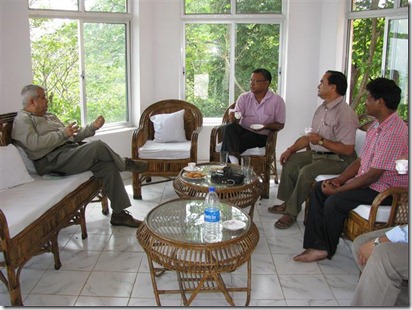
▲ Meeting with Mr. Kazmi
Subsequently we drove back to Jamshedpur in the Swift, very very grateful and relieved that all of us had emerged virtually unscathed from this encounter with Don. The encounter could well have ended in disaster. For city-dwellers like us, it was an experience of a lifetime. Personally, I came across a wild elephant for the very first time in my life and it was a close encounter of a terrifying kind which I’m not likely to forget till my dying day.




